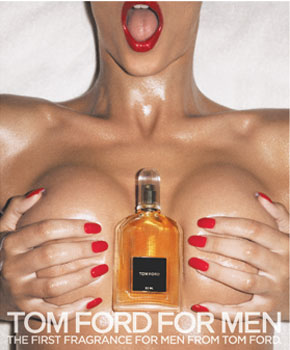





In the world of Tom Ford, every day is a sexual holiday. Metro-sexual, heterosexual, bi-sexual and homosexual, the advertisements for Ford’s lines of clothes, cologne, sunglasses and lifestyle provide viewers with a cornucopia of sexual subjectivities, ripe with the possibility for multiple readings and interpretations. Ford is known for his sexually lavish life-style and sales pitches, in which he blurs and distorts bounded notions of sexuality presenting a stylish visual paradise where the well-dressed, well-groomed and overtly-sexual flourish and frolic in their couture-coveting glory. If advertising is, as delineated by Sut Jhally in “Image –Based Culture: Advertising and Popular Culture,” an image-based “propaganda system for commodities” where “happiness lies at the end of the purchase (Jhally, 252),” what kind of happiness is Ford selling through his materialistic sexual menagerie? I would assert that if advertising is in itself a “part of a new religious system (Jhally, 252),” Ford seems to be the maverick messiah of avant-guard, hedonistic mass-commodified spirituality. A proud gay man himself, Ford is infamous for his sexually explicit magazine appearances--whether he be snapping the toned tush of another man in a fantasy shower scene (obscured only by ill-placed tan lines), lounging with young naked male models on a couch, or playfully seducing a “classically” nude Scarlett Johansson and Keira Knightly on the cover of Vanity fair--Ford features himself prominently and perpetually as the gender-transgressing grand puppeteer of libidinous revelry, controlling, dominating and subjecting the other figures in the scene to his all-powerfull sexual omnipotence. Combining domination with rampant consumerism and sexual heterogeneity, it makes me ponder that if the “commodity image-system…provides a particular vision of the world—a particular mode of self-validation that is integrally connected with what one has rather than what one is—a distinction often referred to as one between “having” and “being”, with the latter…being defined through the former, (252)” what kind of “being” is Ford defining through the possession and purchase of his products and his lifestyle? Clearly he is a man who enjoys his options, yet disturbing to me is the pervasive objectification and denigration to which women are subjected in his quasi-laminated world of build-your-own sexual subjectivity. Blogger activity discusses his latest menswear campaign, in which men “who are obviously gay or extraordinarily metrosexual” (according to blogger assertions) are treated to the crotch-grabbing, clothes-ironing attention of extraordinarily naked women. Is this subjection? Well it certainly seems to be a rather asymmetrically-tilted field of over-exposure Ford is dishing up. One may suggest that this is due to the fact that this is a menswear campaign, in which one could assume the more naked females Ford could pack into his campaign the better in order to entice and entrance heterosexual male consumers. This may have undertones of truth, as perhaps Ford is trying to expand his consumer base through the tempting fantasy of miraculously conjuring an army of sexy naked female servants through new-found fashion fanaticism. Yet interestingly, the men in these advertisements seem remarkably apathetic and indifferent regarding their birthday-suit bound female counterparts. Thus perhaps, in a post-modern market economy, such contrasting and semi-contradictory ocular signifiers allow for, as detailed in Katherine Sender’s “Selling Sexual Subjectivities”, the “construction of multiple narratives…multiple kinds of desire (Sender, 309).” In this chic domain of idealized yet disinterested masculinity, one is presented with the diametric visual opposite of a “stiflingly narrow narrative” (Sender, 308) and is instead treated to a psychically interpretable rainbow of orientations and attractions. Images of the masculine and feminine remain, however—as dictated by cultural standards of conformity—highly circumscribed within rigid bodily measurements and appearances regardless of their ambiguous and rather ambivalent orientations. Such is exemplified in his new cologne campaigns, which feature bottles of Ford’s fragrance strategically positioned in the feminine crevices of baby-oiled, Brazilian-waxed supermodels. One particular ad, in its rather bizarre juxtaposition of women’s genitals and a fragrance supposedly typifying the essence of a man, proves both confusing and crude, moving from the playfully suggestive to oriface-exposing quasi-pornography. It seems, as well, Ford may have missed the mark is his choice of visual pairings, as a particularly incensed “YouTuber” articulated quite bluntly over his self-declared confusion regarding an ad which, for him is saying “Tom Ford Cologne, smell like a pussy (See YouTube video link above).” If Ford is indeed playing with polysemy and multiple perspectives, one could assume such an ad would also entirely (perhaps inadvertently) eliminate his homo-sexual clientele, for although a gay man may be a girls best friend I have yet to meet one wishing to smell like her nether regions. As such, Ford may be the maverick modern Maharajah of non-dominant sexual perspectivism and conspicuous consumerist fantasy, yet there remains the pernicious and perilous topography of one-size fits all sexual imagery--which has ensnared many a product-pusher staking their claim to the entirety of the sexual spectrum--and a discernible undercurrent of female subordination and hegemonic acculturation. Thus, for myself, I shall chalk him up as yet another half-baked post-modern mass-marketed mysoginist....whose only discerning feature is his rather splendid attire.

No comments:
Post a Comment